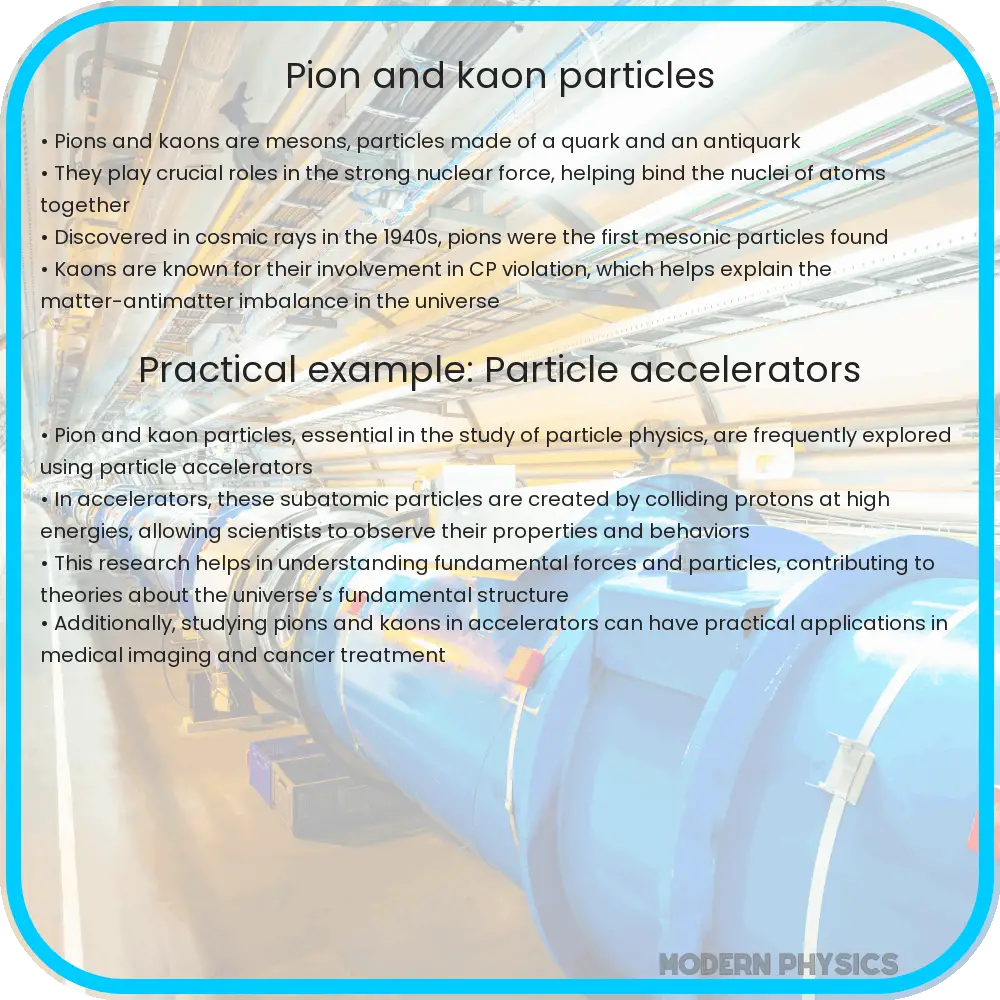Explore the intriguing world of pion and kaon particles, their role in QCD theory, interactions, and impact on fundamental physics and technology.

Pion and Kaon Particles: Fundamental Elements of Particle Physics
Pions and kaons are subatomic particles that play a crucial role in our understanding of the universe at the quantum level. These particles, belonging to a family known as mesons, are composite particles made of quarks and antiquarks, bound together by the strong force, one of the four fundamental forces of nature. In this article, we delve into the intriguing world of pions and kaons, exploring their composition, interactions, and their significance in Quantum Chromodynamics (QCD) theory.
Composition of Pions and Kaons
Pions, also known as pi mesons, are composed of a quark and an antiquark. There are three types of pions: π+ (positive), π0 (neutral), and π− (negative). The π+ consists of an up quark and a down antiquark, while the π− is made of a down quark and an up antiquark. The π0, on the other hand, is a mixture of up quark-antiquark and down quark-antiquark pairs.
Kaons, or K mesons, exhibit a similar structure but involve strange quarks. There are four types of kaons: K+, K−, K0, and K0. The K+ is composed of an up quark and a strange antiquark, while the K− consists of a strange quark and an up antiquark. The K0 contains a down quark and a strange antiquark, and the K0 is made up of a strange quark and a down antiquark.
Interactions and Decay
Pions and kaons are subject to decay, which is a process where a particle transforms into other particles. The decay of these mesons is primarily mediated by the weak force, another fundamental force of nature. For instance, the π+ often decays into a muon (μ+) and a muon neutrino (νμ), while the π0 usually decays into two photons (γ).
Kaons, especially K0 and K0, are known for their peculiar behavior in oscillating between their particle and antiparticle states. This phenomenon, known as K0–K0 oscillation, has been instrumental in studying CP violation, a key concept in understanding the matter-antimatter asymmetry in the universe.
Role in Quantum Chromodynamics (QCD)
Quantum Chromodynamics (QCD) is the theory that describes the strong interaction, the force that holds quarks together within protons, neutrons, and mesons. Pions and kaons, as mesons composed of quarks, are essential in the study of QCD. They provide insights into how the strong force operates at different energy scales and help in exploring the confinement of quarks, a phenomenon where quarks are never found in isolation.
The study of pions and kaons has also been crucial in the development of the Standard Model of particle physics, a theory that explains how the fundamental particles and forces interact. Mesons like pions and kaons help in testing the predictions of the Standard Model, especially in the realm of weak interactions and CP violation.
Is this conversation helpful so far?
Experimental Investigations and Technological Applications
The investigation of pions and kaons is not just theoretical but also experimental, with significant advancements made through particle accelerators and detectors. Facilities like the Large Hadron Collider (LHC) at CERN, and the Fermilab in the United States, have been pivotal in studying the properties of these mesons. Experiments in these facilities collide particles at high energies, creating conditions conducive to the formation of pions and kaons, allowing scientists to observe their behavior and interactions in detail.
Furthermore, the study of pions and kaons has transcended the confines of theoretical physics, finding applications in various fields. For instance, in medicine, pion therapy, a type of radiation therapy, uses the unique properties of pions for cancer treatment. This therapy exploits the distinct way pions deposit energy to destroy cancerous cells while minimizing damage to surrounding healthy tissue.
Challenges and Future Prospects
Despite the progress made, the study of pions and kaons continues to present challenges. One significant challenge is understanding the quark-gluon plasma, a state of matter thought to exist just after the Big Bang. Pions and kaons are among the particles used to probe this primordial state of matter. Additionally, further research into CP violation in kaon decays could provide deeper insights into the matter-antimatter asymmetry of the universe.
The future of pion and kaon research is promising, with advancements in particle physics technology enabling more precise experiments. As we continue to explore the deeper intricacies of these particles, we can expect new discoveries that could potentially revolutionize our understanding of the universe.
Conclusion
Pions and kaons, as fundamental components of the meson family, are more than mere particles; they are keys to unlocking the mysteries of the universe. Their unique properties and interactions provide essential insights into the strong and weak forces, playing a pivotal role in the development and validation of Quantum Chromodynamics and the Standard Model of particle physics. The ongoing experimental research and practical applications in fields like medicine signify the broader impact of these particles. As we continue to probe the depths of particle physics, pions and kaons will undoubtedly remain at the forefront, guiding our quest to understand the fundamental nature of our universe.
